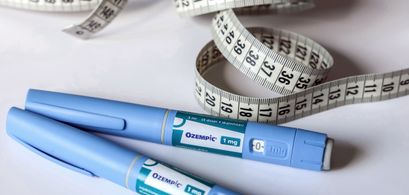- 7% of the entire US population could be on Ozempic by 2035
- Demand for snack and convenience foods could fall by up to 3%
- Ozempic usage could lead to a $3.5 billion deficit for the alcohol industry
- Gym memberships have increased two-fold since the rise of Ozempic
- United Airlines could save $80 million a year with the rise of GLP-1 medications
What have Boris Johnson, Elon Musk and Amy Schumer all got in common, apart from the ability to hold a room? The answer: all three have admitted to dabbling in Ozempic. The wonder drug was originally prescribed as a medication for type-two diabetes but rapidly became better known for its fat-burning abilities. Since it hit the headlines, 22% of Americans have asked their doctor to prescribe them Ozempic for weight-loss, leaving more than half of the nation’s diabetics (52%) struggling to find the medication they need to treat their condition.
It isn’t just diabetics who are struggling due to a rise in the popularity of weight-loss drugs such as Ozempic and Wegovy, but entire industries could soon find themselves in danger. Moneyzine investigates:
.png)
The Fast Food Industry Could Suffer With the Rise of Ozempic
Morgan Stanley estimates that by 2035, 7% of the entire US population could be on Ozempic, which would have a knock-on effect on the food industry. As people start to make healthier choices, traditional snacks that are high in sugar, salt or fat become less appealing. The drug works by decreasing appetite, and those participating in a research survey of 300 patients found that their calorie intake was, in turn, reduced by 20-30% a day. Those calorie savings were mostly made by cutting back on confectionery, baked goods and sugary drinks. As a result, it is predicted that demand for these items could fall by up to 3% by 2035.
There are some indications that the decline could already be underway. Walmart has noticed a slight pullback in the sales of snack foods, which it attributes to Ozempic usage. Barclays believes that the drop in demand could be a real problem for companies such as PepsiCo, FritoLays and McDonalds, to such an extent that it recommends shorting fast food credit.
Not all snack food companies are worried though, and Smucker, which is acquiring Hostess (who make Twinkies and Ding Dongs), firmly believe that snack-foods will always be on people’s radars. Similarly, the Cheesecake Factory draws parallels between the present panic and the ultimately unfounded concerns that the industry had when calorie counts had to be put on menus: a requirement that in fact led to dessert sales increasing, from 14% to 17%.
If, however, Ozempic does have a negative impact on food sales, there can be little doubt that there will be a knock-on effect on other related industries.
Ozempic Could Impact the Beverage Industry
While there are no FDA warnings to suggest that drinking alcohol is incompatible with using Ozempic, many users of the drug simply chose to give up alcohol because of a reduction in the desire to drink. The wine industry is particularly worried, because wine is seen as a social drink and there is a risk that teetotalling Ozempic users will encourage friends to follow suit. There are concerns that this may lead to a drop in sales and a $3.5 billion deficit for the industry.
The tobacco industry is not safe either. Nicotine is well known for its ability to suppress smokers’ appetites and the prospect of weight-gain has deterred many hoping to kick the habit, but with a credible weight-loss drug on the table this could all change. Moreover, there are early indications (yet to be proved definitively) that Ozempic could curb a number of addictive behaviours, not just smoking and drinking. People who were prescribed Ozempic for weight-loss later found that other addictive behaviours, such as nail-biting or shopping, fell into sharp decline.
Ozempic Worries a Dated Diet Industry twofold increase
The $76 billion diet industry is worried, and for good reason. In July, the weight management company Jenny Craig closed after 40 years, and while Ozempic is being blamed, much of the downfall could be ascribed to a major shift in the way the nation thinks and talks about dieting. Body positivity has entered the lexicon, educating the public that healthiness is possible at any size, with Lizzo and Ashley Graham acting as role models for the cause. Ozempic works because people want to lose weight, but don’t necessarily want to label themselves, talk about it, eat branded diets or attend weekly weigh-ins.
Noom and WW (formerly Weight Watchers) have cottoned-on to this and as a result have changed the way that they operate. Noom now offers Noom Med, which offers access to anti-obesity medications like Wegovy through telehealth consultations, and WW, which has faced plummeting stocks since June 2018, noticed a tiny uptick after purchasing Sequence, a prescription-based weight-loss service with access to GLP-1 medications, like Ozempic.
Gym Memberships are Increasing with Ozempic
While it was at one stage thought that gym memberships might decline as a result of the rising popularity of GLP-1 medications, the opposite is actually true. A recent survey found a twofold increase (from 35% to 71%) in weekly exercise by those who had been prescribed weight-loss drugs. The survey’s author attributed this to the fact that the subjects felt more physically and mentally able to exercise. As a result, stock analysts are not only predicting a boom for gyms, but also for workout clothing companies like Lululemon, and even beauty companies like Estee Lauder. The rationale is that positivity breeds positivity, and those who look good like to look even better.
Surprisingly, another industry that could benefit from the rise of GLP-1s is the airline industry. One analyst estimated that United could save $80 million a year if each of its passengers lost 10 pounds. This would reduce the plane’s weight, which in turn would increase fuel efficiency. The benefits could very well be seasonal though, because United have noted that their passengers are on average eight pounds heavier in the winter.
Jonathan Merry, personal finance expert, believes that the latest weight-loss drugs have the potential to have a remarkable impact on both personal and industry-wide levels, but thinks there is one key barrier that needs to be overcome before we see significant change:
In the United States, a month-long supply of Ozempic costs on average of $936, while Wegovy has a list price of $1,349. A price barrier of this scale puts it out of reach for the average American and limits the good that can be done. With obesity costing the public a phenomenal $480.7 billion a year, there could be very real public benefits if these wonder drugs become available to allJonathan Merry, personal finance expert at Moneyzine
Contributors





.jpg)
